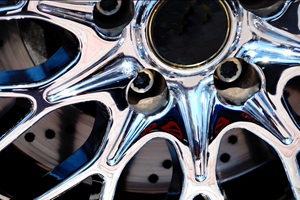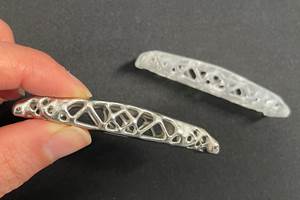Fixing The Cause Of Yellowing In Blue Trivalent Passivate
When parts look great upon initial make-up, but begin to yellow in appearance after 2-4 weeks, Chad Murphy from Columbia Chemical says it can be a number of factors.
Q. We are plating in a zinc barrel line with a blue trivalent passivate. The parts look great upon initial make-up but begin to yellow in appearance after 2-4 weeks. What is causing this and what can I do to address it?
A. There are a number of factors you can explore when it comes to this issue, but the most common cause of a trivalent passivate yellowing is too much iron in the passivation tank. Typically, when the iron level climbs to over 100 ppm, you will start to see issues with yellowing mainly due to iron being incorporated into the trivalent passivate film. This can also cause a loss of corrosion protection up to first white rust. The main culprit for iron levels in the passivation tank is parts on the bottom of the tank. To eliminate this common cause, be sure to drag the bottom of the tank with magnets and keep the tank clean. If you are running a barrel application, inspect your barrels to see where you could be losing parts. Also, high iron levels can sometimes be caused by un-plated surface area such as the inner diameter of tubes or drag-out from your nitric pre-dip tank. It is good practice to regularly clean the bottom of nitric pre-dip tank as well to eliminate this potential problem.
If you have already determined that high iron levels in your passivation tank are not the problem, your problem could be related to thickness of the passivate. Passivate film thickness has a very distinct effect on the color of the film and what the human eye detects in terms of color. Using technology such as x-ray fluorescence, we can measure the thickness of the passivate layer in nanometers and correlate the color of the passivate film to the film thickness. In general, a passivate film measuring between 50-150 nanometers will yield a blue appearance. A film with higher than 150 nanometers will yield a yellow appearance. Film thicknesses of >200 nanometers will yield green and pink colors from the spectrum. Passivates with >200 nanometers are considered thick film passivates and, in most cases, yield an iridescent appearance.
Another factor related to the thickness of the passivate layer is its correlation to corrosion protection. A general rule of thumb is that every nanometer of film thickness will yield approximately one hour of salt spray protection. For instance, a passivate film thickness of 100 nanometers will yield roughly 96-120 hours of salt spray protection as long as all other parameters are optimized.
Now that we have established how the thickness of the passivate can reflect a yellow appearance, we need to explore the four important components that can impact passivate thickness:
- Dip Time. Lower dip time means lower levels of passivate film thickness – higher dip time means higher levels of thickness. Therefore, if your dip time is higher (the part is in the solution longer) causing the resulting film to be thicker, the finish can easily turn yellow. An additional consideration with dip time when running rack lines is the timing of when the first parts hit the solution. If you find you are getting yellow variations between the parts at the top and bottom of the racks you may need to examine your dip time factor and tighten your operating window.
- pH – if your passivation has a lower pH, it will build film faster while a higher pH will build film slower. Since each chemistry has its own pH range, maintain the pH according to the technical specifications provided by your chemical supplier.
- Concentration – higher concentration of the passivate will result in a higher film thickness and lower concentration will result in a thinner film. Again, it is important to pay attention to the recommended concentration provided by your specific chemistry supplier.
- Temperature – if your passivation tank runs at a higher temperature range, it will increase the activity within the tank and build the film quicker, resulting in increased thickness and potentially more yellowing. On the other hand, a lower temperature range will plate slower and provide a thinner film.
A less common potential cause outside of high iron or color variance related to film thickness would be post plate bake times. Long bake times and high bake temperatures can lead to dehydration which can cause yellow discoloration. This is also a factor with air drying when the temperature is elevated.
Again, when comparing all of these potential factors for yellowing of your blue trivalent passivate, the primary cause that a plater can look to is high iron in the passivation bath and the number one cause of that is typically parts in the bottom of the tank. Though each of the suggestions mentioned above are valid in addressing a high iron issue, adjustment of these factors can be more of a short-term solution than a permanent one. The most effective long-term approach once your initial problem is identified and addressed is to focus on prevention of iron build up through the use of specialized iron control additives and passivate conditioners.
Chad Murphy is a Technical Account Manager for Columbia Chemical. Visit columbiachemical.com
Related Content
A Chromium Plating Overview
An overview of decorative and hard chromium electroplating processes.
Read MoreProducts Finishing Reveals 2023 Qualifying Top Shops
Each year PF conducts its Top Shops Benchmarking Survey, offering shops a tool to better understand their overall performance in the industry. The program also recognizes shops that meet a set of criteria to qualify as Top Shops.
Read MorePossibilities From Electroplating 3D Printed Plastic Parts
Adding layers of nickel or copper to 3D printed polymer can impart desired properties such as electrical conductivity, EMI shielding, abrasion resistance and improved strength — approaching and even exceeding 3D printed metal, according to RePliForm.
Read MoreSuccessful South African Plater Beating the Odds
Remaining focused on quality and reliability, Team Plating Works stays profitable in a volatile and challenging economy.
Read MoreRead Next
Education Bringing Cleaning to Machining
Debuting new speakers and cleaning technology content during this half-day workshop co-located with IMTS 2024.
Read MoreA ‘Clean’ Agenda Offers Unique Presentations in Chicago
The 2024 Parts Cleaning Conference, co-located with the International Manufacturing Technology Show, includes presentations by several speakers who are new to the conference and topics that have not been covered in past editions of this event.
Read MoreDelivering Increased Benefits to Greenhouse Films
Baystar's Borstar technology is helping customers deliver better, more reliable production methods to greenhouse agriculture.
Read More
















.jpg;maxWidth=300;quality=90)








